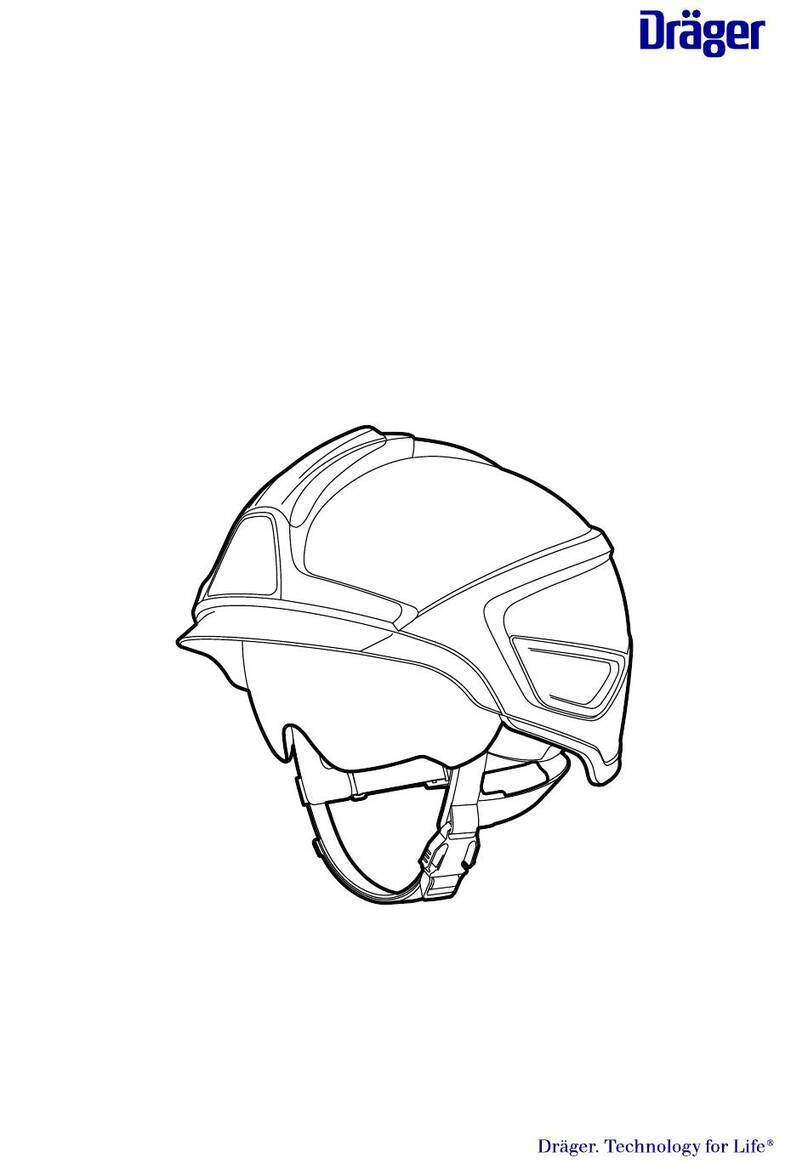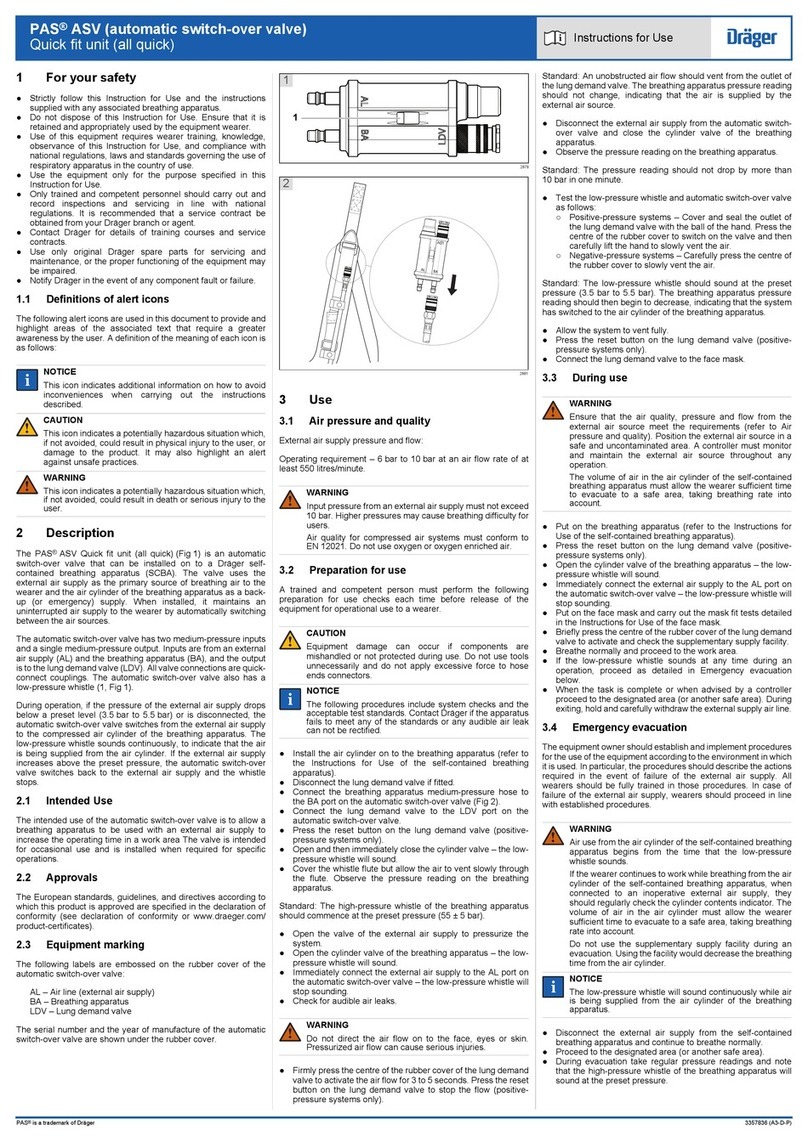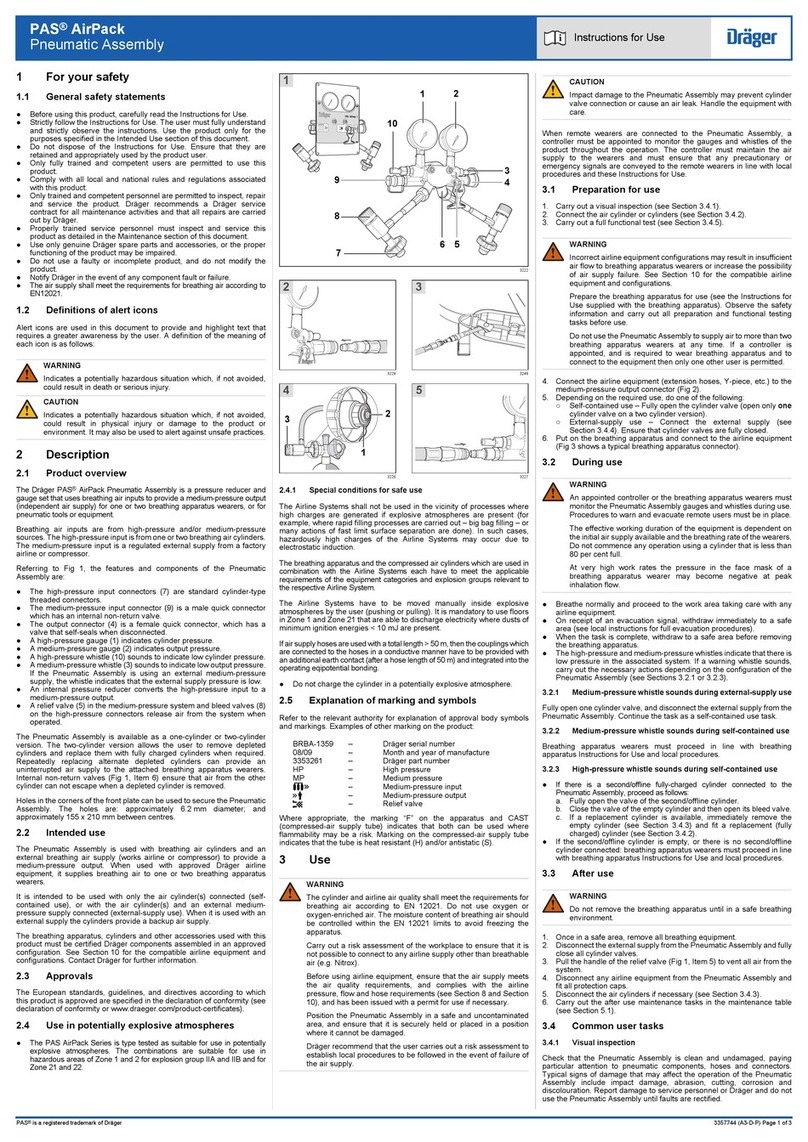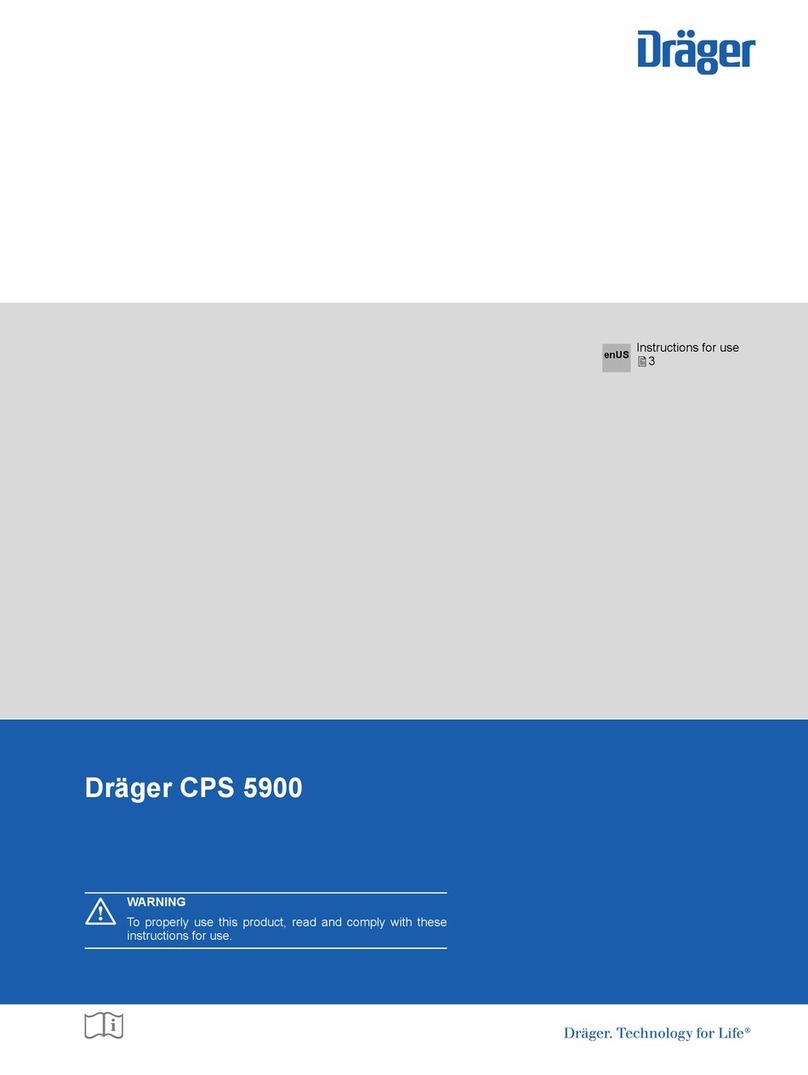
3359880 (A3-D-P)
saver CF Series
Constant-ow escape equipment Instructions for Use
1157
6
3709
4
3697
5
A B C
1
3702
2
3699
3
3694
3700
7
1
2
3
4
5
6
1
3663
8
BA
1 For your safety
1.1 General safety statements
● Before using this product, carefully read the Instructions for
Use.
● Strictly follow the Instructions for Use. The user must fully
understand and strictly observe the instructions. Use the
product only for the purposes specied in the Intended Use
section of this document.
● Do not dispose of the Instructions for Use. Ensure that they are
retained and appropriately used by the product user.
● Only fully trained and competent users are permitted to use
this product.
● Comply with all local and national rules and regulations
associated with this product.
● Only trained and competent personnel are permitted to
inspect, repair and service the product. Dräger recommends a
Dräger service contract for all maintenance activities and that
all repairs are carried out by Dräger.
● Properly trained service personnel must inspect and service
this product as detailed in the maintenance section of this
document.
● Use only genuine Dräger spare parts and accessories, or the
proper functioning of the product may be impaired.
● Do not use a faulty or incomplete product, and do not modify
the product.
● Notify Dräger in the event of any component fault or failure.
1.2 Denitionsofalerticons
Alert icons are used in this document to provide and highlight text
that requires a greater awareness by the user. A denition of the
meaning of each icon is as follows:
WARNING
Indicates a potentially hazardous situation which, if not
avoided, could result in death or serious injury.
CAUTION
Indicates a potentially hazardous situation which, if not
avoided, could result in physical injury or damage to the
product or environment. It may also be used to alert against
unsafe practices.
NOTICE
Indicates additional information on how to use the
product.
2 Description
2.1 Product overview
The Dräger saver CF (constant-ow) is an emergency escape
breathing apparatus that provides respiratory protection to escape
from a contaminated or oxygen-decient environment to a safe
breathing environment.
The main features of the product are:
● The respiratory protection equipment is contained in a carrying
bag that has a soft or hard case. The bag has a neck strap to
carry the product.
● The air cylinder is tted inside the carrying bag but has a
pressure gauge (Fig 1, Item 6) that is visible outside the bag.
When the cylinder is full it provides a nominal duration of 10 or
15 minutes (see Section 2.1.1).
● The cylinder valve/reducer (Fig 1, Item 4) has an automatic
activation device that is operated by removing a two-pronged
locking clip (Fig 1, Item 3). The locking clip is connected by
a strap to a sprung-gate clip (Fig 1, Item 2) that is in turn
connected to a D-ring (Fig 1, Item 1) on the inside of the lid.
This arrangement automatically removes the locking clip as the
carrying bag is opened. When the valve/reducer is activated,
it reduces the cylinder pressure to a medium pressure, and
a preset nozzle inside the valve/reducer provides a constant
ow of breathing air to the escape hood.
● A whistle (Fig 1, Item 5) on the valve/reducer emits a warning
when the cylinder pressure falls to 10 bar to indicate the end of
the rated duration.
● The escape hood (Fig 2) has a rubber ring that seals around
the neck, and an internal nose cup that ts over the nose and
mouth to supply air to the wearer.
● There is an anti-tamper tag (or tags) (Fig 3) tted on the lid of
the carrying bag to allow an inspector to quickly identify that
the bag has not been opened. The soft-case bag has a single
anti-tamper tag (Fig 3, A), and the hard-case bag has two anti-
tamper tags (Fig 3, B).
2.1.1 Air cylinders
The saver CF10 version has a 2 litre aluminium cylinder –
nominal duration of 10 minutes.
The saver CF15 version has a 3 litre steel cylinder – nominal
duration of 15 minutes.
2.2 Intended use
When this product is used with an approved air cylinder it
provides the wearer with respiratory protection for escaping from
contaminated or oxygen-decient conditions. It is intended for
use in applications where a high level of respiratory protection is
required. The air cylinder used with this product must be a certied
Dräger cylinder; otherwise the operation of the product may be
impaired. Contact Dräger for further information.
The product version marked with the
symbol is recommended
where the product is stored in, or regularly exposed to, atmospheres
where airborne hydrocarbons or chemical, fuel or oil vapours may
be present.
Operating temperature range: -15 °C to 60 °C.
2.3 Limitations on use
The saver CF15 version (with 3 litre steel cylinder) exceeds
5 kg. This is considered to be unsuitable (as dened in EN 1146)
to be carried by the wearer for more than 8 hours.
2.4 Approvals
The saver CF Series of emergency escape breathing apparatus
conforms to EN 1146:2005 and ISO 23269-1:2008, and meets the
requirement of EC Council Directives PPE (89/686/EEC), PED
(97/23/EC) and MED (96/98/EC).
PPE - EC Type examiner: DEKRA EXAM GmbH, Dinnendahlstrasse
9, 44809 Bochum, Germany. Notied Body No. 0158.
PPE (89/686/EEC) - 11B examiner: Lloyd's Register Quality
Assurance (LRQA), Hiramford, Middlemarch Ofce Village, Siskin
Drive, Coventry CV3 4FJ, United Kingdom. Notied Body No. 0088.
MED (96/98/EC)/PED (97/23/EC) - Lloyd's Register Verication
(LRV), Hiramford, Middlemarch Ofce Village, Siskin Drive, Coventry
CV3 4FJ, United Kingdom. Notied Body No. 0038.
Use in potentially explosive atmospheres
The saver CF Series is type tested as suitable for use in potentially
explosive atmospheres. The combinations are suitable for use in
hazardous areas up to and including zone 0 and zone 20. The
combinations can be used in atmospheres containing gases of the
gas explosion group IIC.
Do not charge the cylinder in a potentially explosive atmosphere.
3701
9
2.5 Explanation of markings and symbols
The date of manufacture of the product is shown on the carrying
bag in the form MM/YYYY.
is the MED mark of conformity.
3 Use
WARNING
The time required to allow the wearer to escape to a safe
area must be within capacity of the equipment. When
selecting the type and duration of escape equipment it is
essential to consider potential hazards, storage location
and escape routes.
3.1 Preparation for use
WARNING
On receipt of the saver CF from Dräger, the product is
not congured for immediate operational use. The cylinder
automatic activation device is not connected, and the
air cylinder may be discharged. Carry out the following
procedure to prepare the product for use.
Immediately following removal of the equipment from its
packaging:
● If the air cylinder is supplied discharged, see Section 4.2.2 for
cylinder charging instructions.
● If the air cylinder is supplied fully charged, carry out the
following to connect the cylinder automatic activation device:
a. Grip the loop on the lid of the carrying bag and pull up to
open the bag.
b. Seal the lid along the Velcro fastening strip leaving sufcient
opening to insert a hand and, taking care not to detach the
locking clip from the cylinder valve, connect the sprung-
gate clip (Fig 1, Item 2) to the D-ring (Fig 1, Item 1).
c. Fit the anti-tamper tag(s) and close the lid (Fig 3).
3.2 Putting on the carrying bag (ready position)
1. Check that the pointer of the cylinder pressure gauge is inside
the green area, and the anti-tamper device on the lid of the
carrying bag is intact (Fig 3).
2. Place the neck strap over the head (Fig 4, A) and adjust the
strap until the equipment sits in the centre of the chest.
3. If tted with a waist belt (optional accessory), loop the waist
belt around the waist and then fasten the buckle. Pull the free
end of the belt until the equipment is secure and comfortable.
3.3 Putting on the hood and escape procedure
WARNING
The duration begins from the automatic activation of the
cylinder valve and not from time of putting on the hood.
NOTICE
The wearer must be able to reach the required area
before the whistle sounds to indicate the end of the rated
duration.
1. Grip the loop on the lid of the carrying bag and pull rmly upward
to break the anti-tamper tag(s) and open the lid of the bag
(Fig 4, B). This action removes the locking clip, automatically
activating the cylinder valve and the air supply to the hood.
2. Remove the hood from the carrying bag (Fig 4, C).
3. Place both hands inside the neck seal and stretch the hood
over the head (Fig 4, D).
○ Wearers with spectacles – take care when stretching the
neck seal over the spectacles.
○ Wearers with long hair – tuck the hair inside the hood.
4. Position the nose cup over the nose and mouth and breathe
normally.
5. Immediately leave the hazardous area by the shortest and
safest escape route.
WARNING
Do not remove the equipment until in a safe area and clear
of the hazard.
CAUTION
Do not drop or throw down equipment as damage could
occur.
6. Once in a safe breathing environment, remove the hood.
3.4 After use
After any use, the product must be checked and then returned to
the ready-for-use condition. The after use maintenance tasks (see
Section 4.1.2) must be carried out by trained service personnel or
Dräger to prepare the product for use.
D
2











































